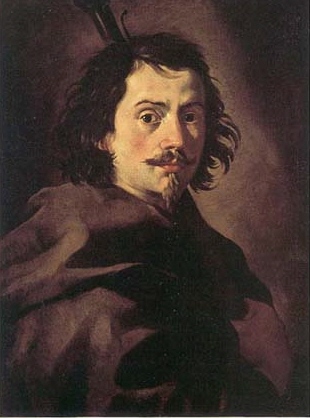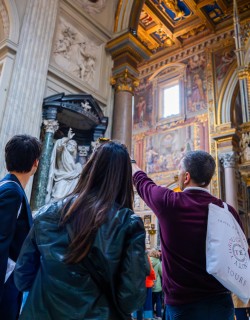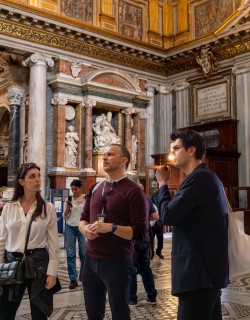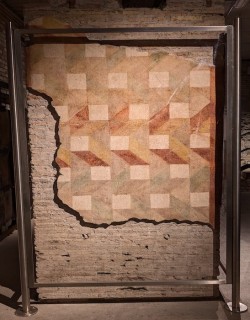Francesco Borromini never looked at structure the same way his architectural contemporaries did in the 17th century. In fact, to this day he makes us look at structures as we’ve never seen them before.
Borromini, an embattled, tortured genius, was the architectural master of illusion. If you’ve never heard of him, it’s because he had the unfortunate timing of coming into his own along with another architect who wasn’t a bad sculptor. A guy named Gian Lorenzo Bernini.
However, Borromini’s famous works can still be seen in Rome. None is more fascinating than the one in the heart of the Centro Storico. The Galleria Spada is in a massive stucco palace in the Piazza Capo di Ferro one block from beautiful Piazza Farnese and two blocks from rollicking Campo dei Fiori. Palazzo Spada was built in 1540 and stands out in a neighborhood of palaces with its intricate fruit and flower carvings on the facade as well as the massive sculpture of Pompey the Great. But what separates it in the neighborhood, as well as from every other museum in Italy, is something else.
Inside the palace is a piece of Borromini’s bizarre architectural genius. Ever see that drawing of the menage of staircases that seem to go up and down but all wind up interconnected in one big circle? This is like that. But that’s only a drawing, an up the down staircase that makes you dizzy if you look at it long enough. On the first floor of the Palazzo Spada, in a small, quiet courtyard, is the real thing. I stared at it for 30 minutes before I finally figured it out.
It’s a colonnade, an open-air hallway lined with columns that looks, at first glance, about 25 meters long. In actuality, when you get closer it’s about 8 ½.
How? Why?
This palace was built in 1540 for Cardinal Girolamo Capodiferro, who helped the Papal States defend against possible invasion from the Ottoman Empire. He died in 1559 and in 1631 Cardinal Bernardino Spada felt it would be his perfect home. One problem: He wanted a spacious garden and the palace itself took up the entire plot of land. There was nowhere to build. In 1635 he hired Borromini to restore the building. He had one major task: make the inside look bigger.
Borromini had a plan. Rome had an Augustinian priest named Giovanni Maria da Bitonto who was a bit of a mathematical genius. Da Bitonto gave him some numbers and Borromini went to work. In the passage of the courtyard, he reduced the dimensions from six meters high and three meters wide at the entrance to two meters by one at the end. He then sloped the floor upward. The two-deep rows of columns are built smaller toward the end of the passage. They frame a statue of Mars, the Roman god of war. It looks as big as any Bernini sculpture in the Borghese Museum. Nope.
The statue is 31 inches tall.
Spada would take guests on a tour of his palace. I imagine he smirked at their remarks about the massive size of his courtyard.
The Spadas came from a wealthy family in Emilia-Romagna in Central Italy and were huge art collectors. The Galleria Spada upstairs contains a nice collection of 16th and 17th century paintings, including Giovanni Domenico Cerrini’s colossal “David with Head of Goliath.” It also houses Pietro Testa’s weird 1640 “An Allegory of the Massacre of the Innocents,” a fine painting if you like looking at a collection of dead babies.
But the Borromini Perspective alone is worth the price of admission. After spending the morning looking and analyzing pictures of the work, I toured the gallery then walked downstairs into the courtyard. When I first saw the colonnade from the rear, I thought I was looking at one of those long, romantic corridors you often see in huge palaces that are half the length of a football field. I tried counting the number of columns and kept losing track.
Then I walked about 20 feet to the entrance.
At that perspective, I could tell. The corridor is only 10 meters long. The sculpture looked as if I could slip into my gym bag and walk out.
Borromini’s life had so many triumphs but he never received his due until his ultimate defeat. He was born Francesco Castelli to a stone mason in Bissone which at the time in 1599 was part of the Swiss Confederacy. He trained in Milan to become a stone cutter but later studied technology of architecture and sculpture.
In 1620, he took a debt owed his father and fled to Rome and started working on St. Peter’s and Palazzo Barberini. By now, Borromini wanted to make a name for himself. So he changed it. It’s believed to be in honor of St. Charles Borromeo, the archbishop of Milan from 1564-1584 and one of the great reformers of the 16th century.
It began to work. In 1634, Borromini received a commission to design San Carlo alle Quattro Fontane. He created an illusion in which the lower walls appear to weave in and out. It looks part cross, part hexagon and part oval. It’s not as famous as some works in Rome as it could fit into one of St. Peter’s dome piers. But it can still be seen near Piazza Barberini at the corner of Via Quattro Fontane and Via del Quirinale.
In 1637 he was named the architect for the Oratory of Saint Philip Neri in central Rome near Via del Filippini and Piazza dell’Orologio. By 1640, the oratory was in use with a taller clock tower and by 1643 the library was relocated. From 1640-1650, he worked on the cornices at Sant’Ivo alla Sapienza near the University of Rome. Today they look like two equilateral triangles forming a hexagon. In 1652, he was one of the architects involved in building Sant’Agnese in Agone for Pope Innocent X who wanted to dress up Piazza Navona.
Borromini, a complex personality

However, Borromini’s temper became as famous as his work. He continually fought with the oratorians of St. Philip Neri. On a building site, he once saw a man damaging some materials and had him beaten to death.
He also had a fierce resentment for Bernini who worked with him on St. Peter’s. Bernini was everything Borromini was not: famous, charming, outgoing. Borromini cared nothing for fashion or money or even sex and lived like it.
Then things began to crumble. In 1656 Pope Innocent X died and the Sant’Agnese project lost steam. Borromini resigned but Bernini picked up the slack and made many changes to Borromini’s design. His work on Santa’Andrea delle Fratte ended. Lateral extensions disfigured his facade of St. Philip Neri. Soon Borromini began illustrating bizarre behavior. He spent weeks without leaving his home. He burned all of his drawings. He suffered hypochondria and hallucinations. Then one day in 1667, he rose in a rage, found a sword and fell on it. He was 68. His suicide note bizarrely blamed his assistant for not turning on his lamp for him.
Because his works were so idiosyncratic for the times, he never received the fame he felt he deserved. Like Caravaggio, another Baroque artist who wasn’t appreciated until later, Borromini began receiving recognition from the art world starting in the 19th century when inventiveness became valued. From 1976-2000, he appeared on the 100 Swiss franc note.
Too bad it all came too late. He should have read the poem Cardinal Spada wrote that can be seen at Borromini’s famed colonnade:
“In the same way that illusions may cause small shapes to appear great, worldly matters held to be great may prove to be illusory and insignificant.”
By John Henderson
Might interest you:




